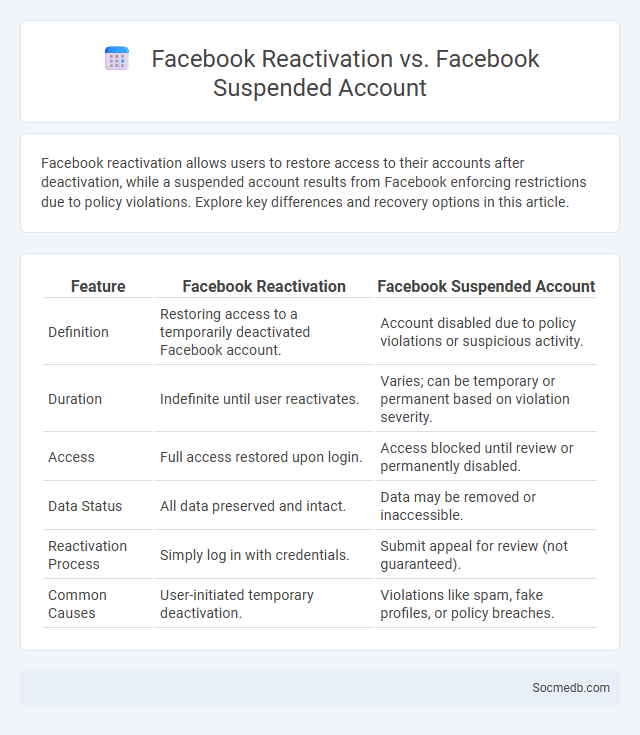
Photo illustration: Facebook Reactivation vs Facebook Suspended Account
Facebook reactivation allows users to restore access to their accounts after deactivation, while a suspended account results from Facebook enforcing restrictions due to policy violations. Explore key differences and recovery options in this article.
Table of Comparison
| Feature | Facebook Reactivation | Facebook Suspended Account |
|---|---|---|
| Definition | Restoring access to a temporarily deactivated Facebook account. | Account disabled due to policy violations or suspicious activity. |
| Duration | Indefinite until user reactivates. | Varies; can be temporary or permanent based on violation severity. |
| Access | Full access restored upon login. | Access blocked until review or permanently disabled. |
| Data Status | All data preserved and intact. | Data may be removed or inaccessible. |
| Reactivation Process | Simply log in with credentials. | Submit appeal for review (not guaranteed). |
| Common Causes | User-initiated temporary deactivation. | Violations like spam, fake profiles, or policy breaches. |
Understanding Facebook Reactivation
Facebook reactivation occurs when a user decides to restore their previously deactivated account, regaining access to their timeline, friends list, and messages. This process typically involves simply logging back into the account, which reactivates all features without losing any stored data. Understanding Facebook reactivation is crucial for users seeking to manage their online presence, privacy settings, and account security effectively.
What Is a Facebook Suspended Account?
A Facebook suspended account is a user profile temporarily or permanently disabled by Facebook due to violations of community standards or suspicious activity such as fake information, spamming, or inappropriate content. Your access to account features, including posting, messaging, and profile visibility, is restricted until the suspension is resolved. Understanding the reasons behind your suspension and appealing through Facebook's official channels is crucial for account restoration.
Reactivation vs Suspended Account: Key Differences
A social media reactivation occurs when your account, temporarily disabled due to inactivity or policy review, is restored with all previous content intact, allowing immediate access to your profile and interactions. In contrast, a suspended account results from violations of platform rules or suspicious activity, often leading to restricted features or permanent bans, significantly impacting your online presence and engagement. Understanding these distinctions helps you navigate account recovery processes and maintain compliance with social media policies.
Reasons for Facebook Account Suspension
Facebook account suspension often occurs due to violations of community standards such as posting hate speech, harassment, or explicit content. Engaging in suspicious activities like creating fake profiles, spreading misinformation, or using automation tools can trigger automatic locks. Repeated policy breaches or security concerns like compromised accounts also lead to temporary or permanent suspension to protect user safety and platform integrity.
Steps to Reactivate a Facebook Account
To reactivate a Facebook account, you must log in using your original email or phone number and password associated with the disabled profile. If your account was temporarily deactivated, you will regain full access immediately after logging in and confirming your identity through security prompts. Ensure your password is up-to-date and check your email for any reactivation instructions to successfully restore your social media presence.
How to Recover a Suspended Facebook Account
To recover a suspended Facebook account, you must first visit the Facebook Help Center and submit an appeal form with your full name, email address, and a valid government-issued ID for identity verification. Ensure your appeal clearly explains any misunderstandings or errors that may have led to the suspension, addressing Facebook's community standards and policies. Your prompt and detailed response increases the chances of regaining access and restoring your social media presence efficiently.
Common Mistakes Leading to Facebook Suspension
Common mistakes leading to Facebook suspension include violating community standards such as posting inappropriate content, engaging in spammy behavior, or using fake profiles. Repeatedly sharing misinformation or participating in harassment also triggers account restrictions. Understanding Facebook's policies and maintaining authentic interactions helps prevent suspension risks.
Preventing Future Facebook Account Issues
Regularly updating your Facebook security settings and enabling two-factor authentication significantly reduces the risk of unauthorized access to your account. Avoid sharing sensitive information and be cautious about the third-party apps you connect to your profile. By maintaining vigilant monitoring of login activities, you can quickly detect and address any suspicious behavior to prevent future Facebook account issues.
Frequently Asked Questions on Facebook Account Status
Facebook users often inquire about verifying their account status to ensure compliance with community standards and prevent restrictions. Common questions include how to check if an account is active, suspended, or subject to warnings due to policy violations. Understanding the Notifications tab and Account Quality section helps users monitor and resolve issues affecting their Facebook account status effectively.
Final Thoughts: Choosing the Right Recovery Path
Selecting the right recovery path from social media dependence hinges on understanding personal usage patterns and the psychological triggers involved. Evidence-based strategies, including digital detox, cognitive-behavioral therapy, and mindful usage techniques, demonstrate significant efficacy in restoring balance. Prioritizing tailored interventions based on individual needs ensures sustained mental well-being and healthier social media engagement.
 socmedb.com
socmedb.com